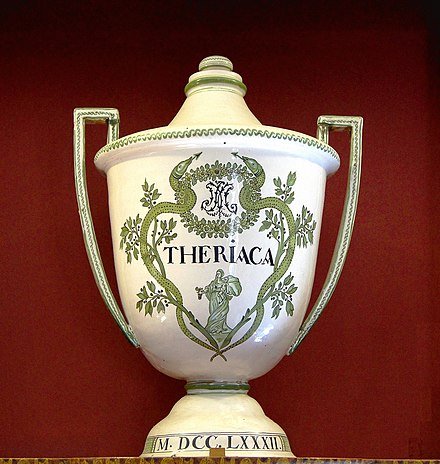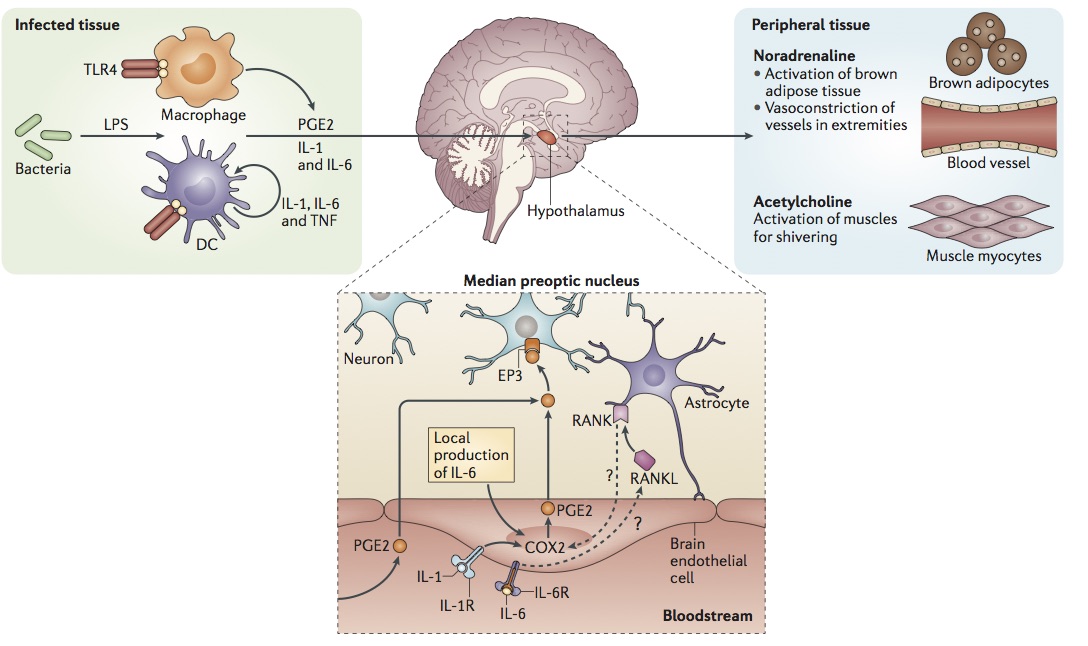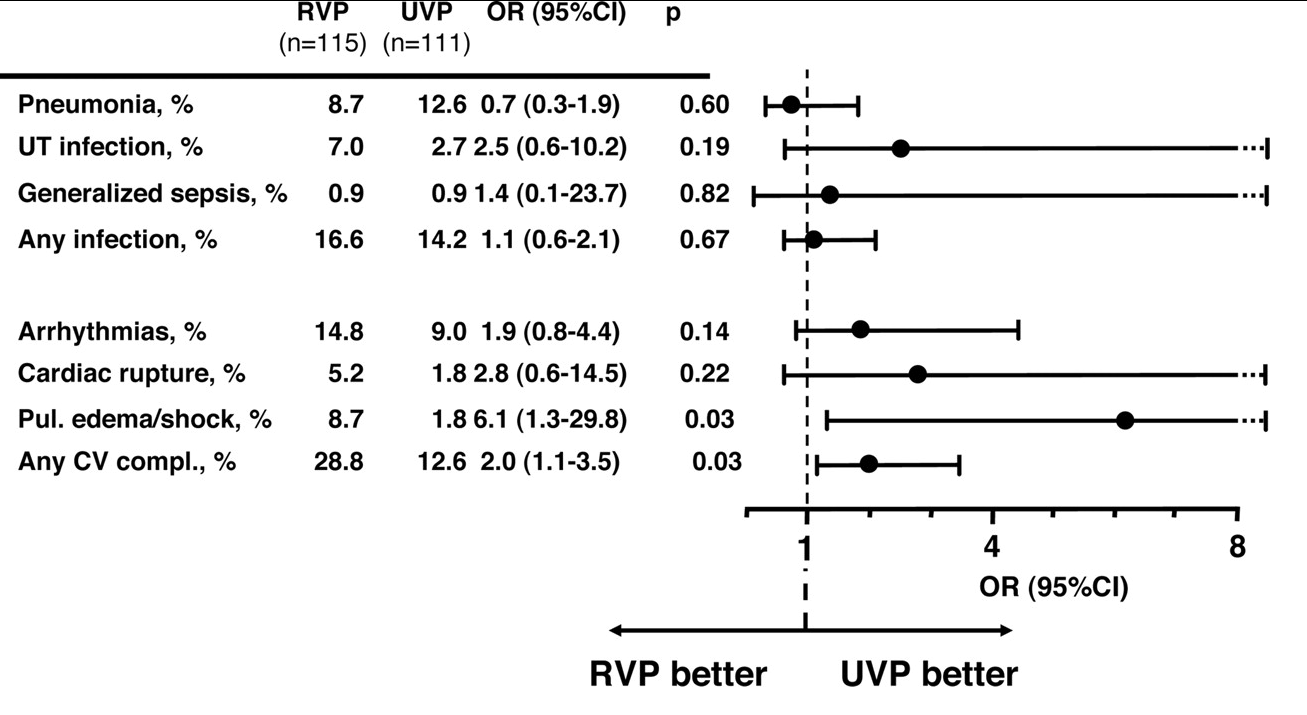Theriac pot, 1782, from here.
In today’s page of Talmud, there is a discussion of the benefits of a fever, which we reviewed in our previous post. It is during this that Rava chimes in:
נדרים מא, ב
אָמַר רָבָא: הַאי אִישָּׁתָא, אִי לָאו דְּפַרְווֹנְקָא דְּמַלְאֲכָא דְמוֹתָא, מְעַלֵּי כְּחִיזְרָא לְדִיקְלֵי, חַד לִתְלָתִין יוֹמִין, וְכִי תִּירְיָיקִי לְגוּפָאי
Rava said: With regard to fever [ishta]…it is advantageous if its incidence is once in thirty days, and it is like an antidote [tiraiki] for poison in the body…
What might this “antidote” be? In his famous dictionary, Marcus Jastrow, explains תִּירְיָיקִי in this way:
So today, we will delve into the strange history of this antidote tiraiki, better known as theriac.
Theriac is mentioned by the Rambam, (הל׳ חמץ ומצה 4:10) and in the Shulchan Aruch, the Code of Jewish Law. There we learn that should any chametz (unleavened bread) fall into your theriac on Passover, the mixture may be kept and used, despite the usual prohibition of mixtures of this sort. Good to know.
שולחן ערוך אורך חיים, 441
והתריאק"ה שנתן לתוכן חמץ מותר לקיימן בפסח שהרי נפסד צורת החמץ
In his commentary on our passage of Talmud, Rabbi Asher ben Jehiel (1250–1328), known as the Rosh, noted that theriac is made from all manner of spices. He would surely know this, because during the time in which he lived, theriac flourished. But theriac predated the Rosh by more than one thousand years…
The second century Greek physician Galen is thought to have authored an entire work De Theriaca ad Pisonem on the healing properties of theriac, and its use as an antidote to poison.
Where did theriac come from?
The word theriac comes from the Greek term θηριακή (thēriakē), meaning "pertaining to animals,” from another word θηρίον (thērion), meaning a wild animal. It is from this word that word “treacle” is derived. Theriac may have originated in the second century BCE., where legend has it that it was developed as an antidote against poisoning by Mithridates VI, King of Pontus. Actually, the king seems to have had an unusual interest in this antidote; he is thought to have tested it on prisoners condemned to death, and hence theriac was once known as mithridatium. The original recipe (and there are many) contained as many as forty ingredients, and over the centuries theriac was variously concocted using all manner of things, although the most frequently listed were viper flesh, opium, wine, honey and cinnamon. Theriac was used for perhaps some two millenia (!) until it declined in popularity in the 18th century. Here, for example, is the Latin theriac recipe of Paul Guldenius, printed in Thorn in 1630. (It is one of only two surviving copies, held by the Gdansk Library of the Polish Academy of Sciences.)
The printed Paul Guldenius Theriac recipe (Gdansk Library of the Polish Academy of Sciences). From Raj. et al. The real Theriac – panacea, poisonous drug or quackery? Journal of Ethnopharmacology 2021: 11
And here is the translated list of the Guldenius recipe:
Also from Raj. et al.
Jews, Theriac and the Black Death
During the terrible outbreak of bubonic plague in the middle of the fourteenth century, and the many that followed, theriac was recommended for its preventive and curative properties. For example, it was discussed by the Italian Jew Abraham ben Hananiah Yagel (1553– c.1624). He was by any definition a polymath. His works include not one but two lengthy encyclopedias, a manual of belief “audaciously adapted from a Catholic manual” and a work in praise of women. But Yagel was first and foremost a physician, and it was in this role that in 1587 he published his first work, a short tract on plagues called Moshia Hosim [The Savior of Those Who Seek Refuge]. “Do not fear the warmth brought on by theriac,” he wrote, “for in small diluted doses it cannot harm anyone.” Those who were sick should dress in clean, comfortable clothes “for they stimulate the sense of touch” and should be surrounded with sheets soaked in a mixture of vinegar and theriac, as well as fresh flowers and sweet-smelling roses “for they uplift the sprits of the sick.”
What should you take if theriac was not available? Good question. Yagel recommended urine:
…those who are learned about nature have taught that it is useful and good to take the urine of a young, handsome, and healthy boy, and to drink it each morning. It will filter out the bad air [that causes the plague].
Hold off your criticism. Yagel here was indeed reflecting the best of contemporary medical thinking. The German medical historian Karl Sudhoff (1853– 1938), who made a career studying almost 300 plague texts from the early Middle Ages, noted that in one Latin treatise on health written in 1405, “older patients who were sometimes counseled to drink a boy’s fresh urine might (understandably enough) feel some nausea.” And the Italian physician named Dionysus Secundus Colle who recovered from the plague around 1348 had this to say:
I have seen women gathering snails and capturing lizards and newts, which they asserted that, once they had all been burnt down to a powder . . . they administered two drachmas of it in a boy’s urine, and they cured and persevered many, and afterward I was compelled to investigate [this cure myself] and afterwards I cured many.
Theriac was also thought to prevent infection. Jacob Zahalon (1630– 1693), the author of Otzar Hahayyim [A Treasury of Life] described his work as both a physician and a rabbi during an outbreak of bubonic plague in Rome in 1656. The plague arrived from Spain and swept over southern Italy, killing over one million people; in the Jewish Ghetto in Rome, according to Zahalon, it lasted some nine months.
When the physician visited the sick, he would hold in his hand a large tar torch, burning it night and day to purify the air for his protection, and in his mouth he had theriac . . .
“Poison antidotes figured prominently as wonder drugs, owing to their powers to cure poison alongside a wider variety of ailments. The ubiquitous theriac and its forerunner mithridatium were prime examples.”
In a recent paper on the healing properties of theriac from a group of Polish researchers, the authors explain the theory behind the use of theriac:
The humoral doctrine, based on the views attributed as far back as to Hippocrates (5th/4th c. BC), assumed the existence in body of four basic substances called the humors. Disturbance of their balance or having them spoiled would cause disease.
The[se] humoral physicians supposed that both for epidemic and intoxication the real cause was a “venom”, entering into body and corrupting its liquids. Hence, drugs believed to neutralize poisons, such as Theriac, were used when a “venom” was diagnosed. Therefore early modern medics recommended the treacle to be used in case of epidemics (when the toxin was considered e.g. airborne) as well as after poisoning, a snake or a rabid dog bite etc.
Contemporaries actually believed that Theriac is a potent anti-epidemic drug. After all, it was used not only during the outbreaks of bubonic plague, the early modern epidemic disease par excellence. For instance, in 1551, during the sudor anglicus outbreak, numerous English physicians regarded the treacle as a staple in prophylaxis, cure and treatment of that mysterious and contagious disease. In the 17th c., London physicians assumed that Theriac might resist measles outbreaks among children and young adolescents. Whereas in German-speaking territories in the 18th c. the treacle was used as a medicine against numerous types of “typhoid fevers” and typhus, smallpox, and other contagious diseases, including the cattle plague. In Muslim world, in turn, it was widely recommended during the outbreaks of cholera.
“כי הטריאקה איננה סם אחד, אבל היא מרקחת רבת ההרכבה, יכנס בה שאור ודבש ובשר שקצים ורמשים, כי יכנסו בה אבק העקרבים ובשר האפעה, כי לכך נקראת כן, כי הארס בלשון יון תריאק. וכן בלשון תלמוד טרקיה חויא (שבת קט:), וכן הוזכרה המרקחת בלשונם כי טוריאקה לכוליה גופא (נדרים מא:), וחלילה שיכנס בקטורת בשר שקצים ורמשים ושאור
Theriac [called “triga” by Rashi] is not one ingredient but is a compound of many ingredients, containing leaven and honey, the flesh of forbidden animals and reptiles, for the powder of dried scorpions and the flesh of the viper go into it, this being the reason why it is so called [theriac], for “poison” in Greek is called theriac.
So also in the language of the Talmud:“Torkai (stung by) a serpent.” Similarly this compound is mentioned in the language [of the Rabbis]: “as theriac is good for the whole body.”’”
Fake Snake oil and Genuine Snake Oil
Over the centuries, theriac was concocted with all manner of different exotic ingredients. But how could the consumer be sure they were getting the real-deal theriac, and not some useless knock-off? Through a poison trial, obviously.
In her fascinating recent book The Poison Trials: Wonder Drugs, Experiment and the Battle for Authenticity in Renaissance Science, Alisha Rankin, a professor of history at Tufts University in Boston describes how theriac and other wonder drugs were tested. Often, a pair of criminals condemned to death would be used. They were given a poison like aconite (which comes from a genus of flowering plants which includes monkshood) and then one of them received the theriac. One such Poison Trial took place in 1524 and was overseen by the physician to Pope Clement VII. Here is Rankin:
Led by the pope’s personal physician Paolo Giovio, the doctors gave both prisoners a good quantity of a deadly aconite called napellus, enough to kill “not merely two men, but one hundred.” As the poison took effect, the prisoners started to gesticulate wildly and cry out from the pain in their hearts. Immediately, Caravitia [a surgeon who had created the antidote and offered it to the pope] anointed one of them with some of the oil, and the man’s heart and pulse quickly returned to normal. The other prisoner, who was given no antidote, died in great agony…
Less than two weeks later, a four-page pamphlet appeared in print, described as a “Testimony of the most true and admirable virtues of a composite oil against plague and all poison, with which an experiment was conducted by distinguished men, at the command of the Supreme Pontiff Pope Clement VII, in the Roman Capitoline edifice.”
Still, these trials did not convince everyone. Galen had written that “there is much trickery practiced about the drug by tricksters.” During the Renaissance period, there was concern that the theriac was inferior or outright fraudulent. The same concerns were raised about another cure-all: unicorn horn, and apothecaries had to go to great lengths to prove to the satisfaction of their customers that the horn came from a genuine unicorn.
But did it work?
It probably goes without saying, but I will say it anyway. There is nothing that we today would count as scientific evidence to suggest that theriac, in any of its recipes, actually worked. The same group of Polish researchers we cited above carefully reconstructed theriac from that the recipe of Paul Guldenius (and you can read their fascinating paper here). They concluded that “only two species included in Theriac can be harmful in humans: poppy and sea squill, but in both cases the calculated quantity of morphine and cardiac glycosides, respectively, were below toxic level.” Well at least that. And here are some more of their observations:
Summing up the results, due to the extreme complexity of the Theriac recipe after theoretical analysis it is easier to say what pharmacological effect the medicine did not have than what it actually had. Historical and phytochemical investigations have consistently shown that – at least in the Early Modern period – the assumptions regarding narcotic or toxic effects of Theriac are not supported by the results. On the other hand, taking into account the compounds one can expect positive results in antioxidant tests or antimicrobial and anti-inflammatory activity. Still, at the moment there is no indication that the famous panacea’s efficacy in the main indications was based on anything more than just a placebo effect.
This too, seems to have been understood by at least one talmudic rabbi. In reply to Rava’s statement that having a fever once every month was “as good as theriac,” his contemporary Rav Nahman bar Yitzchak had this brief retort:
לָא הִיא וְלָא תִּירְיָיקָה
- Give me neither a fever nor theriac!













